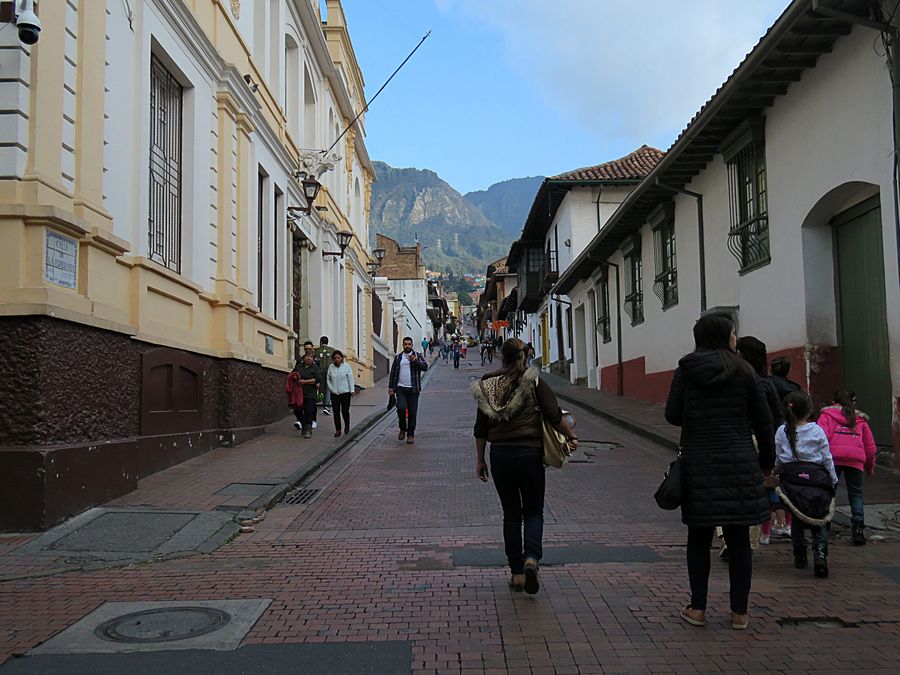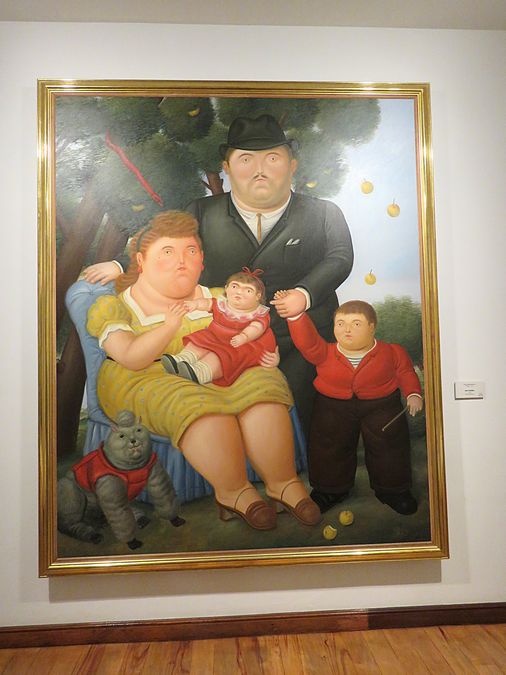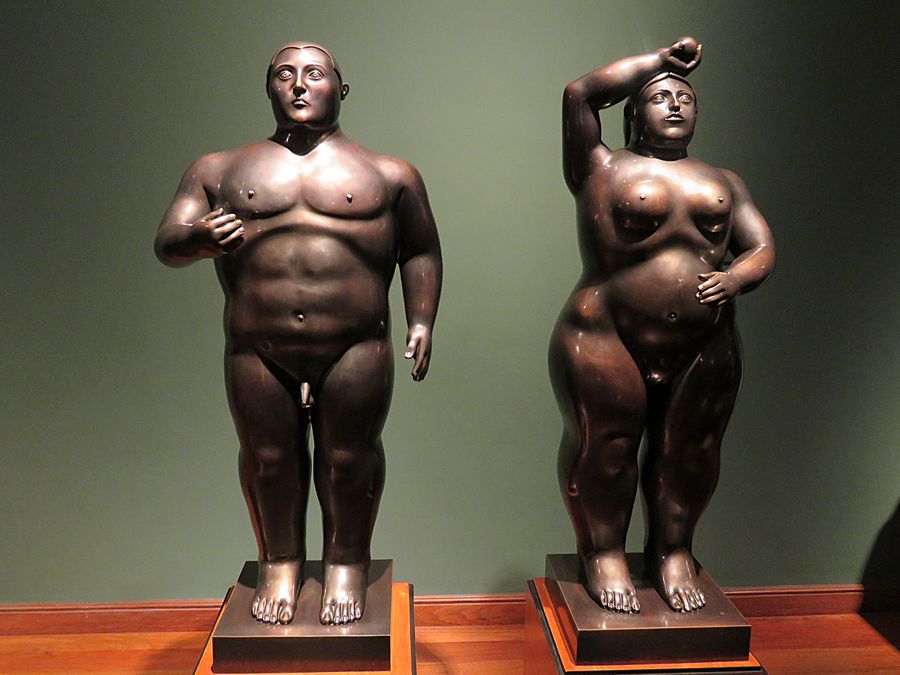Colombia's Colonial Jewels & the Coffee Triangle
with pre-trip to Bolivia: La Paz & Lake Titicaca
January 31 - February 19, 2019
Part Two, Page One: Colombia: Bogota
Colombia shares a border to the northwest with Panama, to the east with Venezuela
and Brazil and to the south with Ecuador and Peru.
Colombia is a
constitutional republic, comprising thirty-two departments. Colombia has been
inhabited by various indigenous people since 12,000 BC. The Spanish
arrived in 1499 and by the mid-16th century colonized much of the region,
establishing the New Kingdom of Granada. Independence from Spain
was achieved in 1819. Gran Colombia is a name used today for the state that included
much of northern South America and part of southern Central America from 1819 to 1831.
It included the territories of present-day Colombia, Ecuador, Panama, Venezuela,
and parts of Peru, western Guyana, and northwestern Brazil.
By 1830 the Gran Colombia Federation was dissolved, with what
is now Colombia and Panama emerging as the Republic of New Granada.
Panama seceded in 1903, leading to Colombia's present borders.
The U.S. intentions to influence the area (especially the Panama Canal construction and control)
led to the
separation of Panama in 1903 and the establishment of it as a nation.
The U.S. paid Colombia
$25,000,000 in 1921, seven years after completion of the canal,
for redress of President Roosevelt's
role in the creation of Panama.
Colombia is one of the most
ethnically and linguistically diverse countries in the world with indigenous peoples,
European settlement, forced African migration, and immigration from
Europe and the Middle East.
Between the late 1940s and the early 1950s, there was a period known as La Violencia ("The Violence").
Its cause was mainly mounting tensions between the two leading political parties, which subsequently ignited
after the assassination of a Liberal presidential candidate (Gaitan) in April 1948.The ensuing riots in Bogota
spread throughout the country and claimed the lives of at least 180,000 Colombians. Since the 1960s, the country
has suffered from low intensity armed conflict between government forces, leftist guerrilla groups and right wing
paramilitaries.
The conflict escalated in the 1990s, mainly in remote rural areas. The administration
of President Uribe (2002–10), adopted the democratic security policy, which included an integrated counter-terrorist
and counter-insurgency campaign. The Government economic plan also promoted confidence in investors.
As part of a controversial peace process the AUC (right-wing paramilitaries) as a formal organization
ceased to function. In February 2008, millions of Colombians demonstrated against FARC and other outlawed groups.
After peace negotiations in Cuba, the Colombian government of President Santos and the guerrilla group FARC
announced a final agreement to end the conflict. However, a referendum to ratify the deal was unsuccessful.
Afterward, the Colombian government and the FARC signed a revised peace deal in November 2016,
which the Colombian congress approved. In 2016, President Santos was awarded the Nobel Peace Prize.
The Government began a process of comprehensive reparation for victims of conflict. Colombia
shows modest progress in the struggle to defend human rights. A Special Jurisdiction for Peace
has been created to investigate, clarify, prosecute and punish serious human rights violations
and grave breaches of international humanitarian law that occurred during
the armed conflict and to satisfy victims' right to justice.

In Bogota, the capital city
Historic La Candelaria area, where Bogota was born.
Bogota has over 8 million people.

Bolivar Square, named after Simon Bolivar who led
Colombia to independence. The National Capitol in
the background. The Cathedral on the left, from the
18th century.

Colombians call them Hormigas Culonas. Foreigners call them “Big-Ass Ants."
They’re shiny, about as long as the top joint of your thumb,
body split into three sections, long transparent wings attached,
little pinchers on the head. In the Santander region of Colombia,
the giants ants are a favorite snack, a delicacy. We saw lots of
street vendors selling them in Bogota.

Pat about to eat a big ass ant. I'll try almost anything
once. In this case, probably once is enough.

Artifact in Del Oro or Gold Museum, home to the world's
biggest collection of pre-Hispanic gold artifacts.

Man standing outside the Gold Museum in Bogota,
making a living selling pictures with the llama.

Some of us took a tram up to Monserrate overlooking Bogota.
Monserrate Sanctuary is a Catholic shrine built
between 1650 and 1657 and is 10,341 ft. above sea level.
We could look down from this area to see Bogota in the
valley below. However, it was so cloudy and especially
smoggy, the view was limited.

View from Monserrate looking toward the mountains
behind Bogota

Part of Monserrate Sanctuary

Flower in full bloom at Monserrate

Back in town on the street where our hotel was located in the
historic La Candelaria area. Looking back up to the surrounding
mountains.

Baby in front of our hotel

At Plaza de Paloquermao Market in Bogota where
we strolled through stalls filled with fresh cut flowers,
herbs, all kinds of fruits, vegetables, meat, and fish.

Colombia is second only to the Netherlands as the leading
exporter of cut flowers in the world.


I have never seen such a wide variety of fruits.
Many fruits I had never seen before.

Vendor at the market holding a huge fish for sale

Local guide in a neighborhood filled with urban graffiti.
In 2011 a young graffiti artist, Diego Felipe Becerra, was shot dead by police
when creating his signature image of Felix the Cat
on the walls of an underpass in the Colombian capital.
Police tried to portray him as a suspected armed robber,
but outcry over the death, along with condemnation from the UN
and a flurry of graffiti protests across the Colombian capital,
sparked a wave of change for graffiti and street art and how it is viewed.

Gustavo Petro, then mayor of Bogota, issued a decree
to decriminalize graffiti and street art painting
to help promote what was seen as a new form of
artistic and cultural expression, but with the agreement that
certain areas should remain free from graffiti, such as
public buildings and monuments. Of course, the nature of graffiti
and street art is to play against the rules, so many
creators headed for the off limit areas to leave their marks,
which makes for an uneasy tension with the authorities.

As recently as 2014 problems arose, when Police authorities
again became overzealous and tried to paint out all
the graffiti on Calle 26, an area famous for hosting
works by local and international names. Interim Mayor Rafael Pardo
had to meet with concerned graffiti and street artists after they complained.
The mayor indicated the police had gone too far and were only
supposed to remove works not officially sanctioned.
This followed an incident in October 2013 when Justin Bieber was out doing
graffiti on Calle 26 and near to the spot where Diego Felipe Becerra
was shot, the irony being that Bieber was given an escort by Bogota police.


The modern section of downtown Bogota

Inside the Botero Museum in Bogota. The museum, which
belongs to the Banco de la República de Colombia, was
founded in 2000 when Botero donated more than 100 of his
own works,
along with 85 from his personal collection of other
artists' work– including pieces by Picasso, Monet, Matisse
and Klimt.
The painter curated the museum himself.
This is Botero's representation of himself with his
children and wife.

Botero's sculpture of Adam and Eve
Fernando Botero Angulo is a Colombian figurative artist and sculptor.
Born in Medellín, his signature style depicts people and figures in large,
exaggerated volume, which can represent political criticism or humor.

Looking up the street from the Botero Museum in Bogota

One of many impressive looking churches in the La Candelaria
area of Bogota.

Our tour leader Diego (on the left) with a married couple who
spoke to us about their past. She had joined the
guerrilla (leftist) movement at 14, leaving behind a bad
situation at home. He had fought with a paramilitary
(far right) group. When they met and started
communicating with each other, they realized neither
person was a monster and eventually fell in love,
married and have a child. It was an inspirational story.
Link to Part Two, Page Two - Medellin, Colombia
Pat's Home Page